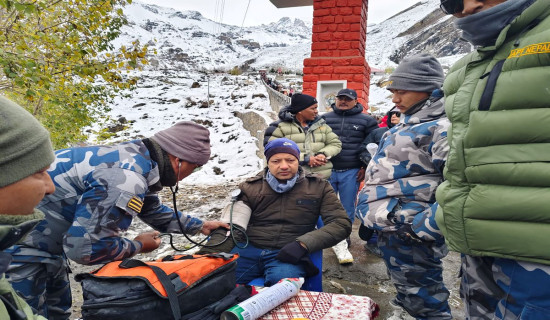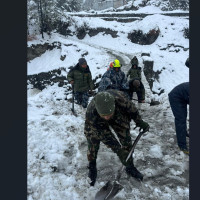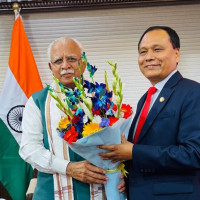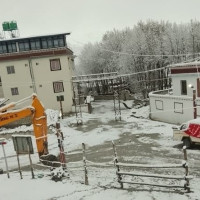- Thursday, 30 October 2025
Protecting The Mundhum Trekking Trail
The Mundhum Trekking Trail (MTT) is a recently established cultural walking trail in eastern Nepal, offering a serene journey through mountainous landscapes. Opened in January 2018, this trail spans the upper temperate climate zones along the mountain ridge connecting Bhojpur and Khotang districts. With an elevation ranging from approximately 2,000 meters to 4,165 meters (Silichung peak), MTT provides a unique opportunity for an accessible trekking experience. While there is no significant risk of altitude sickness, trekkers are advised to take necessary safety precautions. The trek primarily follows a camping route, although trekkers have the option to stay in a mix of accommodations such as hotels, basic tea houses, and camping sites.
The name "Mundhum" highlights the cultural richness of the Kirati people, the indigenous inhabitants of this region, in addition to showcasing the natural wonders of the mountains. The trail traverses through various ethnic settlements, including Chakhewa Vanjyang at the border of Khotang and Bhojpur districts, Mehrung Hill, Maiyung Hill, Lauri Hill, Shalpa Pokhari, Shilichung Peak, and returns to Bhojpur Bazaar through Maiyung Hill and Suntale Hill. This diverse route allows trekkers to immerse themselves in the cultural heritage of the local communities while appreciating the stunning beauty of the surroundings.
Attractions
The MTT offers not only cultural experiences but also breathtaking views of the Himalayas, verdant valleys, and lush forests throughout the trail. One of its exceptional features is the opportunity to witness six of the world's eight-thousander peaks, including the towering Mount Everest (8848 m), Lhotse (8516 m), Lhotse Sar (8382 m), Makalu (8463 m), Cho Oyu, and Kanchenjunga (8586 m). Additionally, trekkers can marvel at other prominent peaks such as Dudh Kunda, Karyalung, Kusumkhang, Ama Dablam, Thamserku, Kyashar, Khangtega, Chamlang, Mera Peak, Barun Himal, Kumbhakarna Himal, Langtang, Gaurishankar, and over 45 more peaks along the trekking trail. These majestic vistas add an extra layer of grandeur to the overall trekking experience.

The MTT is immersed in a tapestry of rich culture, religion, festive celebrations, and a vibrant lifestyle, predominantly showcased by the Kirati people who speak more than 10 distinct languages. However, the region also encompasses Sherpa, Tamang, and other communities, adding to the cultural diversity. Every location along this trail is intricately connected to Kirat culture and the essence of Mundhum. Two significant landmarks, Shalpa Pokhari, and Shilichung Peak, hold immense sacred importance as pilgrimage sites for the Kirati people. The Salpa Pokhari region is believed to be the dwelling place of Summing and Prumha, revered figures from the ancient Kirat civilisation. Kirat Mundhamis, Dhamis, Bijuwas, and Nakchongs consider Shalpa Pokhari and Shilichung as the abode of their gurus and a sacred zone, where regular offerings (puja) and prayers are conducted. The trail derives its name from the unique Mundhumi culture, which is deeply rooted in the traditions and heritage of the Kirati people.
Biological diversity
The Mundhum region is not only culturally vibrant but also exceptionally rich in terms of biological diversity, wildlife, watersheds, and wetland ecosystems. It boasts of dense upper temperate forests, flourishing watersheds, expansive grasslands, and a variety of plant species such as Rhododendron and bamboo. The region is home to a range of threatened wildlife species including the Red Panda, mountain eagles, deer, Himalayan giant honeybees, leopards, bears, and the Danfe (Himalayan Monal) bird. Particularly notable along the trail is the presence of the Himalayan Ghoral (Naemorhedus sp.), a goat antelope species, and the habitats where mountain eagles hunt these goats. The transition from sub-alpine to alpine landscapes in the high mountains offers breathtaking beauty, with trees giving way to vast grasslands as one ascends.
As the trail winds through settlements where the Kirati people have resided for generations, trekkers can experience the remarkable bio-cultural diversity of the region. It is estimated that there are over 200 cattle sheds (known as goth) scattered throughout the area, housing important livestock such as yaks, sheep, cows, and buffaloes. This harmonious coexistence of human settlements and diverse ecosystems adds a unique dimension to the trekking experience in the Mundhum region.
In recent times, there seems to be a conflict between modern development activities and environmental conservation, particularly trekking routes in Nepal. Many trekking routes have been supplemented by road networks, and there are few initiatives to restore these routes.

It has become common to see trekkers walking on unpaved motor roads, covering their faces with handkerchiefs to protect themselves from the dust raised by passing vehicles. Unfortunately, there is a prevailing notion in Nepal that equates development with the construction of roads. The extensive road construction in mountainous terrains has exacerbated monsoon hazards such as landslides, floods, and damage to infrastructure. It is evident that development models need to be aligned with the fragile mountain landscapes and ecological systems, but unfortunately, this realisation has come too late.
Adverse impacts
Considering the unique bio-cultural, geological, and ecological significance of the Mundhum trail, any attempts to construct roads in and around the trail should be carefully evaluated. There are ongoing efforts to expand road networks up to Salpapokhari from Bhojpur, Khotang, and Solukhumbu districts. Such road construction would have serious implications for emerging tourism in the region, as well as for the geomorphology and bio-cultural diversity of the area. The mountain trail passes through vast pasturelands and meadows that are essential for local livestock. Additionally, there are several wetlands along the trail, including Hans Pokhari, Kubhinde Pokhari, and Salpapokhari. Construction of roads around the trail could lead to the destruction of these wetlands, impacting not only the biodiversity but also the hydroclimatic balance in the region.
Considering the relatively small settlements along the MTT, the urgency for roadways is not apparent. The main pilgrimage site for the Kirat people, Salpapokhari, holds a significant geological importance as it accumulates runoff water after snowmelt, acting as a reservoir that supports downstream agriculture and forest ecosystems. Instead of advocating for road expansion, efforts could be directed toward investing in tourism infrastructure along the trail, such as hotels and teashops. Such initiatives would encourage trekking and tourist activities in the region, ultimately improving local livelihood.
The Mundhum Trail is a naturally formed trekking trail that has been used by the Kirat ancestors of eastern Nepal. It was revived and reconstructed by the Mundhum Trail Development Committee (MTDC) in January 2018. This trail holds immense potential for authentic mountain trekking experience, given its rich bio-cultural diversity and pristine mountain environment. Despite the limited tourist facilities in the region, the trail has already gained popularity among national and international visitors. It is crucial to preserve and protect this trail rather than pursuing irrelevant and short-sighted concepts of linking it through road networks at any cost.
(Dr. Tiwari is a plant ecologist at Central Department of Botany, Tribhuvan University.)






-original-thumb.jpg)










